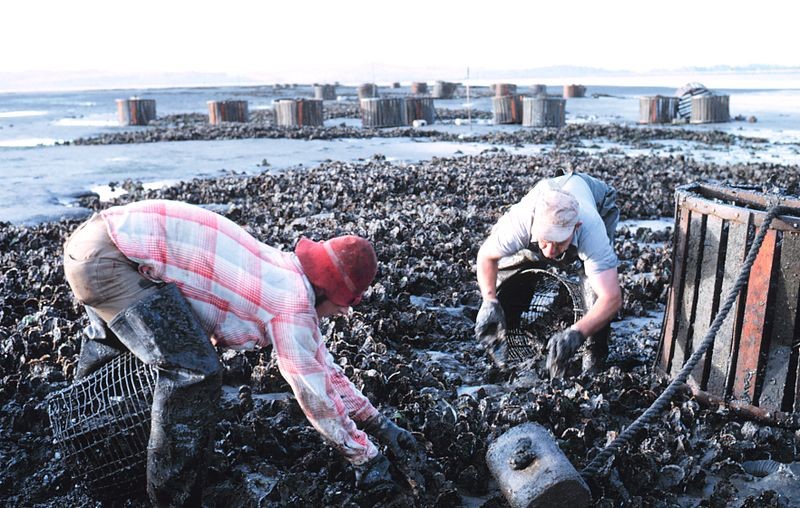Oscar Heanue is a recent law graduate and student in the Harvard Law School Food Law & Policy Clinic. He is a guest contributor to this blog.
For most, the term “farm” likely conjures images of rolling fields of grain or livestock grazing in a pasture. For some, the term may bring to mind grimmer images of factory farms overstuffed with animals destined for a slaughterhouse.
Most would not, however, imagine oyster beds or pools of water overflowing with shellfish. Yet shellfish aquaculture – the practice of farming bivalves such as oysters, clams, and mussels – is covered in the Farm Bill and represents an important and growing part of the US food system.
What is shellfish aquaculture?
Shellfish aquaculture involves farming oysters, mussels, or clams from a larval stage through the years-long process of maturation into an edible state. Farming occurs in ocean water, either through a “bottom culture” process which uses the ocean floor as the base for the farm, or through an “off-bottom culture” process, in which the bivalves are kept floating in a controlled, open-water environment. An off-bottom approach may be more expensive, but can help farmers to avoid losing their shellfish crop to environmental factors such as predators, suffocation beneath the sand, or weather-related drift.
Bivalve farming has grown into a large, nationwide industry that stretches the lengths of both coasts. In 2016, the US produced nearly 50 million pounds of bivalves through aquaculture, with the industry valued at approximately $340 million. There are regional hubs of shellfish aquaculture on both coasts, with Washington State and the Chesapeake Bay region serving as the nation’s leading shellfish producers.
What are the benefits of bivalve farming?
Farming bivalves may have positive externalities that stretch well beyond economic profits to shellfish farmers. Bivalve production can offer a sustainable, healthy, and relatively affordable alternative to more resource-consumptive forms of animal agriculture.
When compared to other farmed sources of animal protein, bivalve aquaculture is unique due to its low carbon footprint and potentially positive ecological impacts. Farmed mussels, for example, have been found to have the lowest carbon footprint of any animal protein source, with GHG emissions associated with mussel farming as much as 60 times lower per kilogram of edible product compared to beef production. Bivalves are more than just the lesser of many evils when it comes to environmental impact, though. Shellfish farms may have a restorative effect on natural ecosystems due to bivalves’ role as natural filter-feeders. Aquaculture operations have been associated with regrowth of natural fauna while simultaneously avoiding the degradative effects typically associated with anthropogenic operations in waterways.
Additionally, bivalves may be a beneficial addition to people’s diets. Bivalves are protein-dense and rich in Omega-3 fatty acids, and some bivalves, such as mussels, are among the cheapest available sources of animal protein.
What policies are in place that impact shellfish farmers?
The National Aquaculture Act of 1980 defined marine aquaculture as a form of farming, bringing shellfish aquaculture under the ambit of the USDA. Bivalve farming is included in the Farm Bill, and Congress has recently used the Farm Bill as an occasion to offer new protections and funding for the industry. The 2018 Bill improved access to crop insurance for shellfish farmers, giving coverage to the entire life cycle of shellfish crops and expanding protections beyond oysters, which had been the only bivalve previously covered. Additionally, aquaculture groups celebrated the inclusion of aquaculture in a $40 million funding initiative to research environmental and production efficiency for livestock.
More recently, Congress has seen new legislation introduced in the name of promoting aquaculture that could have negative impacts on the status of aquaculture workers. The Shellfish Aquaculture Improvement Act of 2021 would limit employer liability for suits involving the wrongful death or injury of workers in the aquaculture industry. Though the legislation has yet to make meaningful progress, the Bill would represent a step backward for the rights of employees in an industry that Congress had recently taken the opportunity to promote.
Going Forward
Shellfish aquaculture presents a unique opportunity to produce healthy animal protein in an environmentally conscious and sustainable way. While Congress’s interest in promoting aquaculture in the 2018 Farm Bill represents a promising start, there remains further room to support domestic aquaculture. The US shellfish market is still highly import-dependent, with the US ranking as the third-largest global importer of oysters despite its growing domestic industry. Congress should use the 2023 Farm Bill as an opportunity to provide additional support and funding for local aquaculture, including additional aid to help promote research and development of best-practices for shellfish farming operations. With proper support, the shellfish aquaculture industry’s current growth may be here to stay.
The views and opinions expressed on the FBLE Blog are those of the authors and do not necessarily reflect the official policy or position of FBLE. While we review posts for accuracy, we cannot guarantee the reliability and completeness of any legal analysis presented; posts on this Blog do not constitute legal advice. If you discover an error, please reach out to contact@farmbilllaw.org.


